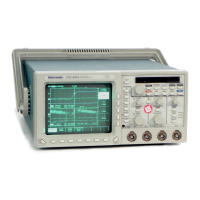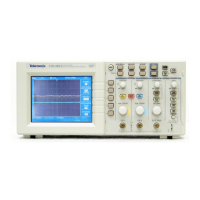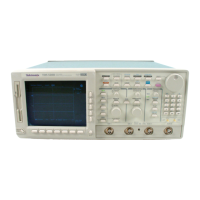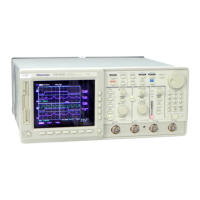TDS 420A, TDS 430A, TDS 460A & TDS 510A User Manual
3–67
Logic Triggering (TDS 510A Only)
There are two classes of logic triggering: pattern and state.
A pattern trigger occurs when the logic inputs to the logic function you select
cause the function to become TRUE (or at your option FALSE). When you use a
pattern trigger, you define:
The precondition for each logic input — logic high, low, or do not care
The Boolean logic function — select from AND, NAND, OR, and NOR
The condition for triggering — whether the trigger occurs when the Boolean
function becomes TRUE (logic high) or FALSE (logic low), and whether the
TRUE condition is time qualified (see page 3–71)
A state trigger occurs when the logic inputs to the logic function cause the
function to be TRUE (or at your option FALSE) at the time the clock input
changes state. When you use a state trigger, you define:
The precondition for each logic input, channels 1, 2, and 3
The direction of the state change for the clock input, channel 4
The Boolean logic function — select from clocked AND, NAND, OR, and
NOR
The condition for triggering — whether the trigger occurs when the Boolean
function becomes TRUE (logic high) or FALSE (logic low)
Table 3–4 on page 3–68 lists the preconditions required for each logic function to
issue a pattern or state logic trigger.
Logic Trigger Readouts
At the bottom of the display, the Trigger readout shows some of the key
parameters of the logic trigger (see Figure 3–35).
NOTE. When Logic is the selected trigger type, the threshold levels that help
determine triggering are set for each channel individually in the Set Thresholds
menu. Therefore, the Trigger Level readout will disappear on the display and the
Trigger Level knob can be used to set the threshold level while the Main Trigger
menu is set to Logic.

